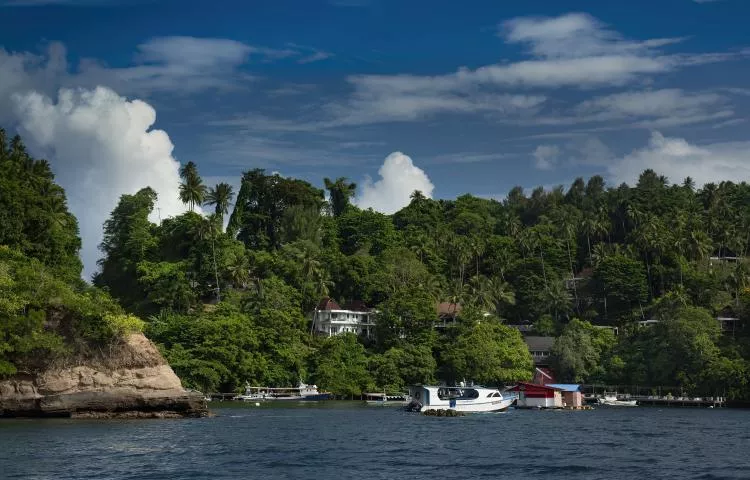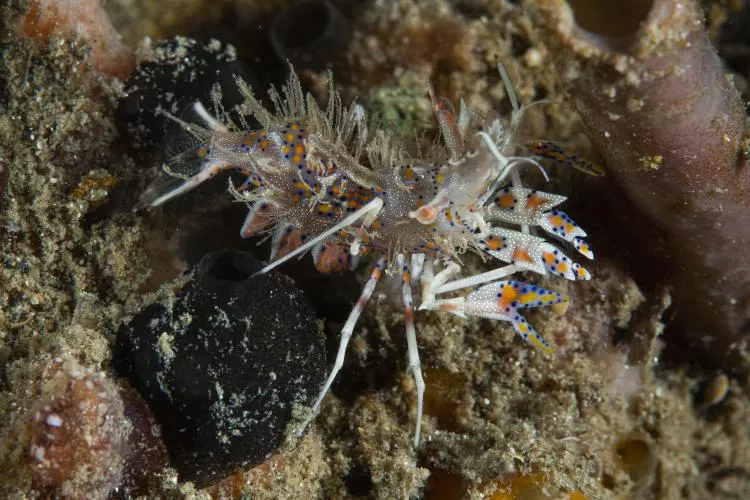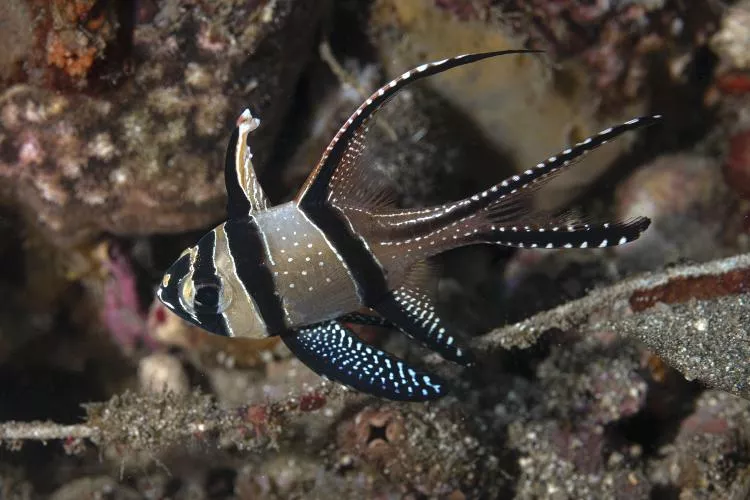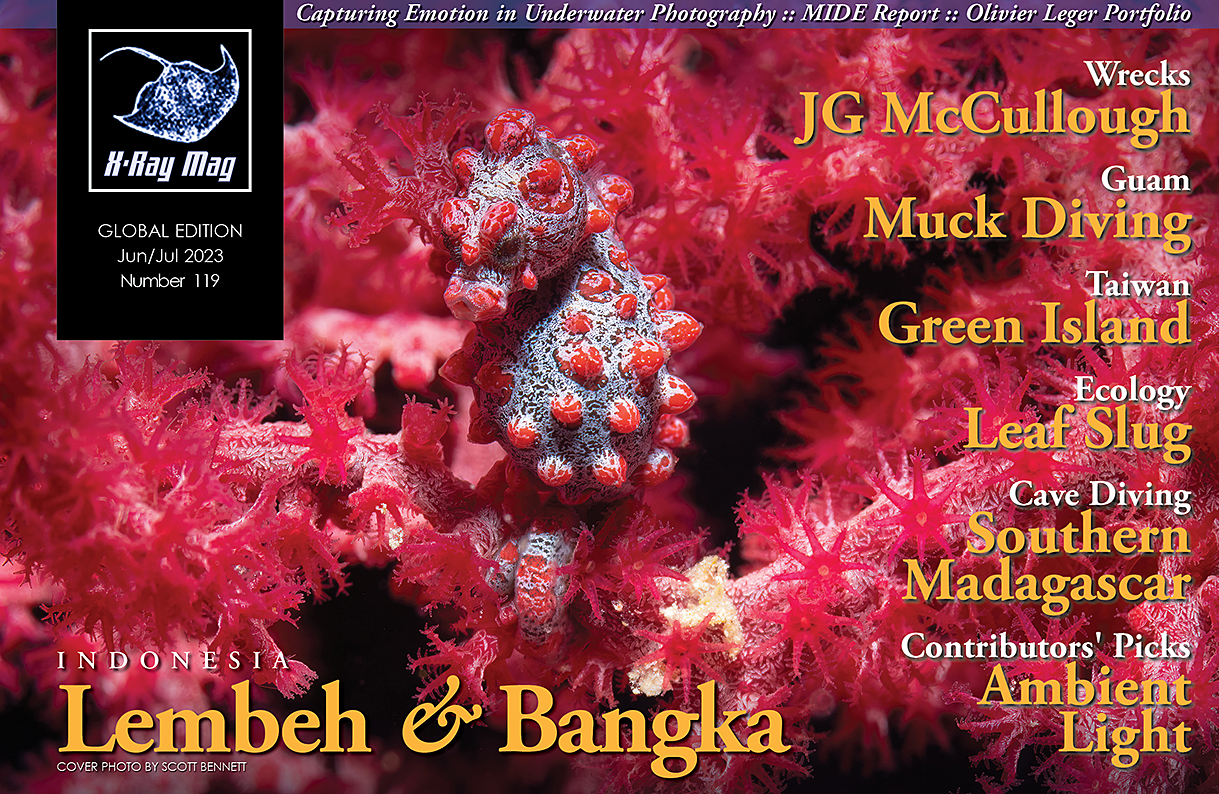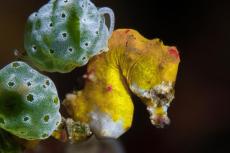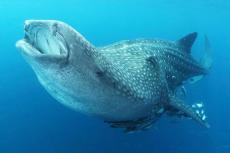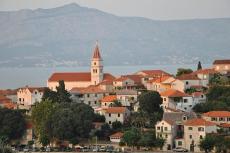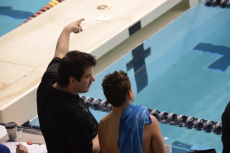When it comes to diving, Indonesia has no shortage of bucket-list worthy destinations, boasting some of the most biologically diverse tropical reefs and critter sites in the world. For the macro photographer, North Sulawesi’s Lembeh Strait is the proverbial Holy Grail. To the uninitiated, prowling a featureless expanse of sand may border on the unhinged, but critter enthusiasts will beg to differ, as Lembeh’s environs are home to a dizzying array of the weird and wonderful. Scott Bennett has the story.
Contributed by
I first visited way back in 2004 after a liveaboard trip to Raja Ampat with the legendary Michael Aw. He and some others opted to extend the trip with a few days at Lembeh Resort. Armed with my first housing for an SLR camera, I was eager for more diving. How could I refuse?
The experience was magical! With more than 90 dive sites to choose from, I saw and photographed creatures I did not even know existed. The only problem? The housing was for a film camera and the subjects per dive far exceeded the images per roll of film. Right then and there, I knew a return visit with a digital camera was imperative. I managed to return in 2006 for a few days with a housing for a Nikon D200. This time, I could shoot as many images as I wanted per dive. It was now official; I was hooked on macro!
Sadly, it would be a number of years before my next visit. I had been thinking about it, but then 2020 rolled around, and we all know what happened next. In November, after months in lockdown, an online dive show was announced. One of the exhibitors was Lembeh Resort, which was advertising its “Critters at Lembeh” workshop slated for January 2022. I signed up in a heartbeat. After all, the pandemic would be over before then, right? Right???
So much for optimism. By late 2021, Indonesia had yet to open to international tourism and the workshop was delayed until January 2023. It seemed the day would never come, but by late 2022, the borders were opened, and the workshop was on!
Getting there
From my home in Toronto, a trip to Indonesia is no easy jaunt. To break up the trip, I stopped in Singapore for a few days before continuing on to Manado. Going through Customs was quick, and I collected my luggage and headed outside to meet my transfer to the resort. The drive to the jetty in Bitung was a lot faster, courtesy of a new expressway, effectively halving the travel time to 90 minutes. Motoring across the channel to the resort, everything looked as I remembered but with one difference. The natural arch on one of the islands had collapsed only months before my arrival, a sobering reminder of nature’s impermanence.
Arriving at the resort, I was greeted by guest relations manager Tarkan Sever. After two years of trading emails, it was great to finally put a face to the name. After a welcome drink, I had a quick tour of the resort.
It was an odd sensation; I had been here before, but everything was unfamiliar. Many upgrades had been made over the years, with many rooms being totally refurbished. The only thing I recognised was the pool! There was also a fully equipped photo centre operated by Backscatter, with a wide variety of products for sale. This would prove to be a godsend, but more on that later.
I was then taken (by Tarkan) to my accommodation, a luxury hillside bungalow I was sharing with another participant. Encircled by luxurious tropical vegetation, it featured a bedroom, sitting room, open bathroom, and stunning views overlooking the strait. On the opposite shore, the volcanic peaks of Mt Tongkoko and Mt Klabat dominated the landscape. The latter, at 1,995m, is Sulawesi’s tallest peak.
Photo workshop
With everything unpacked, I examined the printout of the week’s schedule. The daily activities would be intense: Breakfast starting at 6:15 a.m., followed by a half-hour seminar at 7:00 a.m., then followed by a two-tank dive departing at 8:00 a.m. Back by noon, lunch would follow at 12:30 p.m., another seminar at 1:30 p.m. followed by a third dive at 2:15 p.m. From 5:30 to 7:00 p.m., the instructors would be on hand in the main lounge for processing questions, with participants urged to bring their laptops. After dinner at 7:00 p.m. came an image critique on the lounge TV at 8:00 p.m. After that, it was time to ready camera gear for the next morning, followed by bed. Repeat for the ensuing week!
With that in mind, I collected my gear and headed for the camera room to set up. At Lembeh Resort, photography is king, evidenced by the bright and spacious camera room. Each station featured ample space for equipment assembly, along with an abundance of plugs for battery charging. Twenty-four-hour electricity was an added bonus.
My photo gear consisted of a Nikon D850 camera in a Seacam housing with twin Inon Z-330 strobes. I brought along two macro lenses: a Sigma 105mm and a Nikon 60mm. Kit assembled, I set out for the lounge to meet the workshop’s three instructors: Erin Quigley and Joel and Jennifer Penner.
Erin Quigley is an Adobe ACE certified expert in Adobe Photoshop and Lightroom. An award-winning underwater photographer and editor, she is also the creator of GoAskErin.com, providing one-on-one instruction, custom video tutorials and post-production resources developed specifically for underwater photographers.
Accomplished underwater photographers and videographers Joel and Jennifer run Newmediasoup, a Central California-based multimedia design company providing digital design, corporate video, photography, consulting and marketing solutions.
I was one of the last to arrive, with everyone already having done a day’s diving. The group was predominantly from the United States, with participants from Canada (me included), the United Kingdom and the Netherlands. Within two hours of my arrival, the entire staff knew my name, putting me at a distinct disadvantage as I forget names in five minutes. After dinner, I called it an early night. With the schedule ahead, I suspected sleep would be a rare commodity.
Diving
Finally, after more than two years, the workshop’s first day had arrived! After breakfast, we watched “Rules of the Muck,” a presentation about general photo etiquette and procedures during a muck dive. Lembeh Resort must have the biggest staff I have ever seen at a dive resort, numbering around 90 personnel. Many worked in the dive centre, either as guides, boat crew or doing dive gear preparation. For those wanting to be spoilt rotten, this was the place. Literally, everything was done for you, from readying and rinsing gear to carrying cameras to the boat.
The three dive boats took a maximum of eight guests, and each visited a different site, ensuring a lack of crowding. My boat was the Moana for most of the week, with Opo and Jeffry as our guides. Despite the large number of dive resorts in the area, there was never any competition, as only one group could dive one site at a time. Underwater, dive etiquette prevailed, ensuring everyone had a chance to photograph a subject, especially if it was one that was coveted by all.
Kapal Indah. The morning began at Kapal Indah, named after the wreck of a large fishing trawler resting upright on the sandy bottom at 30m. We did not even get that far when a myriad of critters appeared from the get-go. You know it is going to be a good week when your first critter is a flamboyant cuttlefish. Leisurely trundling across the sand, it allowed ample opportunity for everyone to get some shots.
The critter parade continued, with painted frogfish, an anemone with commensal shrimp, thorny seahorse, robust ghost pipefish and whip coral gobies following in rapid succession. Opo’s spotting proved exemplary, pointing out a tozeuma shrimp on an orange sponge I surely would have missed. With hour-long dives the norm, it was great having time to experiment with different exposures and strobe positions.
Tandurusa. After our interval, our second dive was at Tandurusa, translated as “deer horns” and named after the nearby village. Typical of Lembeh sites, it featured a gentle slope of gentle sand and rubble. Here, we photographed pygmy pipehorse, yellow filefish, dwarf scorpionfish, brown gobies and serpent pteraeolidia nudibranchs (called dragon nudibranchs by the guides). Opo wrote, “Shaun the Sheep nudibranch,” on his slate. I could not even see it but aimed my camera where I thought it was. I did capture it but calling it “small” in the image was an understatement!
After lunch and a presentation on Module Workflow by Erin, it was time for our final dive.
Tanjung Kusu-Kusu. Tanjung Kusu-Kusu is named for the tall grass growing on the cape near the site, with “Tanjung” meaning “cape” and “Kusu-Kusu” meaning “wild grass”. Along with familiar characters such as flatworms, thorny seahorse, commensal shrimp and whip coral gobies, there were some real surprises. Hiding under an overhang was a comet, a species I had never seen before. Amazingly, it came out into the open and I got the image.
Then, Opo indicated something on the sand, which I initially thought was a miniscule nudibranch. Even with my 105mm lens, it was a mere blip in the frame. Back at the resort, I discovered it was a Kuiter’s dragonet, one of the world’s smallest fish species. I could not wait to see what the rest of the week had in store!
A plethora of species
With eight days of diving, a description of each site and the critters within would require a novel’s worth of text. Many of the Lembeh stalwarts appeared, along with species I had never encountered before. No repeat dive was ever the same, as the critters moved about, sometimes vanishing in mere hours. Every site provided wonderful photo opportunities, but several were standouts. Some, such as Critter Hunt, Retak Larry, Slow Poke and Aer Bajo, I had visited on previous trips, but the majority were new to me.
Trying out new equipment
Workshop participants were allowed to borrow equipment from the resort’s photo centre to try out. I was eager to use a snoot for spotlight effects, something I had never done before. Signing it out in advance, I discovered a minor hiccup. The Backscatter mini strobe with snoot attachment had an optical connection, while my Seacam housing had electrical only. Happily, there was a solution. I set the mini strobe to slave in manual mode, so my primary strobe would fire it. I just had to be careful aiming the primary strobe at the mini strobe and not illuminate my subject.
Kareko Pasar. As it turned out, our dive site had the perfect subject to try it on. Kareko Pasar was home to fire urchins harbouring Coleman shrimp, one of my favourite subjects. It did not take too long to find an urchin with a resident pair. Aiming the snooted strobe proved tricky at first, as maneuvering it to spotlight the subject took some practice. After a few attempts, I got an image I was very happy with.
Other notables included a white-eyed moray, male banded pipefish with eggs, commensal shrimp, hermit crab and various nudibranchs. A large Glossodoris laying eggs was a standout.
ROJOS. Fifteen minutes from the resort, ROJOS is named for the Lembeh Resort dive guides and crew that discovered it: Ronald, Opo, Joni, Ona and Salmon. And it was a good thing they did! Subjects included coconut octopus, Napoleon snake eel, dwarf scorpionfish, Halgerda batangas nudibranchs, robust ghost pipefish, cockatoo waspfish, common lionfish, juvenile cube boxfish and a decorator crab carrying a jellyfish.
Kareko Batu. My week’s undisputed highlight was a dive at Kareko Batu. I christened it “the octopus dive,” as four octopus species made an appearance. First was a coconut octopus half-buried in the sand, followed by a mototi octopus, another species I had never seen before. An inconspicuous brown at first, it turned bright yellow—the two iridescent blue rings warning of its venomous punch.
Moments later, Opo found a wonderpus octopus! Striped and delicate, it glided across the sand, its tentacles gently flailing as it settled. Although the subject was small, I needed a wider coverage with ample depth of field and my 60mm lens did the trick. We stayed with it for over 10 minutes and I photographed to my heart’s content. Just then Joel appeared, and I happily yielded so he could shoot some video. A few metres away, a long-armed octopus appeared. Incredibly, all four were in an area under 10 square metres!
And if that wasn’t enough, a huge Bobbitt worm foraged out in the open, disturbing a Napoleon snake eel, which promptly exited its burrow. I even managed a shot of the two together. Seriously, what are the odds of that? Oh, and did I mention there were cuttlefish?
Pintu Colada. However, there was one notable critter on my wish list: the blue-ringed octopus. In three decades of diving, I had yet to see one. Well, Pintu Colada delivered! The little blue-ringed octopus at this site also proved especially compliant, allowing a close approach for photos. When it flashed its blue rings, I kept a safe distance. One does not want to enrage one of the most venomous creatures in the sea! Although the octopus stole the show, plenty of subjects vied for my camera’s attention, including margined Glossodoris, giant mantis shrimp and striped fang blenny.
Nudi Falls. Not all of Lembeh’s sites are on volcanic sand. Only seven minutes from the resort was Nudi Falls, one of my favourite sites from previous trips. Featuring a small wall packed with colourful sponges and nudibranchs in only a few metres of water, it is named after the fact that the bubbles from divers’ tanks sometimes cause nudibranchs to fall off the wall above and drift down. At around 18m, a sea fan is home to a Bargibant’s (pygmy) seahorse (Hippocampus bargibanti).
Here, we were presented with a photographic dilemma: harlequin shrimp or pygmy seahorse? As both were deep at different parts of the site, it was one or the other. Harlequin shrimp, please! Plunging in, there was plenty to photograph en route. A white humpback scorpionfish postured, while farther down, we encountered a pair of harlequin shrimps.
The wall was stunning, adorned with an astonishing array of corals and sponges. A snowflake moray peered from a crevice, while a barramundi cod, elegantly attired in white with black spots, allowed a close approach.
I also photographed Banggai cardinalfish for the first time on the trip. Originating from Sulawesi’s Banggai Island, legend has it that a bag of aquarium-bound specimens was accidentally released into the strait. They have proliferated since and can now be seen alongside anemonefish. Interlopers or not, they are undeniably striking and great photo subjects.
Culinary delights
A highlight of every day was mealtime. The food was a culinary adventure, featuring a mixture of local and international dishes. Several nights had themes, such as Thai or Indonesian. Although breakfast and lunch featured a buffet, dinner was à la carte, with several choices, which were preordered during lunch. A good thing too, as a daily three-meal buffet would ensure the button on my pants taking out someone’s eye.
Blackwater diving
One day, Joel presented a session on blackwater diving and announced we would have the opportunity to try it. Blackwater diving is essentially a night dive, but rather than exploring a reef by torchlight, it concentrates on creatures attracted from the deep by means of a high-powered light source. The prospect of diving at night in open water with no discernible bottom was daunting, especially while carrying camera gear. Nevertheless, new experiences are good things and I decided to give it a shot.
At dusk, our intrepid group of six set out, with excitement and apprehension. As we were mostly newbies, it would not be a true blackwater dive. Instead, it would be a “bonfire dive,” with a floodlight on a stand set up on the bottom at around 18m and turned on. After around 15 minutes, the light would attract a variety of planktonic creatures, including fish larvae, jellyfish, worms, octopus and salps. Joel had suggested to use a 60mm lens.
Initially, all I could see was a snowstorm of miniscule creatures and struggled to focus. Instead, I finned to the bottom, where I found some zebra and dwarf lionfish hunting. A nearby family of blacksaddle anemonefish crowded their host, their docile demeanour a welcome relief from their almost comical daytime aggression.
Joel pointed out several transparent creatures, but hovering in mid-water while trying to focus on such small subjects was extremely challenging. At the very end, I was rewarded with an image of a minute larval octopus. Although I said “never again” at the conclusion, the experience has since grown on me, and I am eager for another go.
Photo seminars
The remainder of the week followed a similar pattern. The photo seminars proved both educational and inspiring, with technical topics in the morning and Lightroom techniques in the afternoon. Joel and Jennifer covered photo techniques, while Erin dazzled with her Lightroom skills. Ensuing topics included Composition, Abstracts, Snooting, Creative Backgrounds and Super Macro, with live equipment demonstrations also displayed on the lounge’s big screen.
Afternoon Lightroom sessions included Module Workflow, Backscatter and Water Replacement and Masking Magic. One of my favourites was the ominously named Advanced Dark Arts with Macro, featuring advanced compositing and masking techniques. Erin demonstrated things I did not even know were possible. The masking capabilities in Camera Raw were far more sophisticated than I imagined. Information overload was the order of the day; it was impossible to remember everything. Fortunately, as workshop participants, we could join Erin’s Lightroom Boot Camp Facebook page, where heaps of additional info could be found.
Every day, one of the instructors would come along on each dive boat, alternating as the week progressed. Once aboard, I marvelled at the camera equipment on display. I thought my equipment was big; Erin’s kit for shooting video was immense, adorned with a hodgepodge of strobes, spotting lights, and attachments reminiscent of the Mars rover. One morning, everyone assembled their camera equipment to pose for a group photo. The monetary value on display was gobsmacking, likely exceeding the GNP of some small countries.
Flooding
As any photographer on a dive trip can confirm, the absolute worst-case scenario is a flooded housing. Well, you can now add me to that list. On a return trip to Nudi Falls, I was determined and eager to see the pygmy seahorse. Descending to 18m and with the sea fan in sight, I suddenly heard beeping; I was horrified to discover it was my housing’s moisture detector! Holding the housing port face-down, we beat a hasty retreat for the boat. The safety stop seemed to last an eternity!
Once on board, I opened the housing and braced for the worst. Miraculously, despite having water inside, the camera and electronics remained intact! Once the other divers were back, I was dropped at the resort, so I could fully assess the situation. After several dunks in the rinse tank, I could see water was getting in, but I could not determine where the leak was. With six diving days left on my trip, the prospect of a defunct camera system was unpleasant to say the least! Fortunately, it was Joel to the rescue.
If there was any place for this to occur, I could not think of a better one than a resort with a professional photo centre and a professional photographer. Upon examination, he concluded that the culprit was an improperly greased O-ring on the port. When I bought the housing, I did not have a vacuum system installed. As luck would have it, Joel had one left in stock that fit my housing. Ten minutes later, I was good to go!
However, by this point, moisture had gotten in around the circuit board, causing my strobes to go haywire when fired. It was Joel to the rescue again. He gave me some silica gel packets, which we placed around the circuit board and sealed the housing for the night. The following morning, the strobes worked perfectly, giving a worst-case scenario a best-case conclusion. Thank you, Joel!
Pulau Abadi. It was then time to put my housing to the test. Our first dive was at Pulau Abadi, and I was definitely on edge. Despite the new vacuum pump, I half expected the alarm to go off at any moment. Happily, everything worked perfectly, and I could once again focus on photography. A good thing too, as there was a plethora of critters to shoot. Tiger shrimp were the star attraction, along with striped catfish, peacock mantis shrimp, ribbon eels and plenty of nudibranchs.
Frogfish
For the workshop’s final days, we visited some new sites as well as revisited a few others including Bianca, Pulau Abadi, Serena Besar, Kareko Pasar and Kareko Batu. One of Lembeh’s most endearing subjects must be the frogfish. Boasting a mélange of shapes, colours and sizes, we found them at many of the sites. Painted, warty and hairy frogfish were common, especially the latter which were routinely encountered lumbering across the substrate.
Makawide 2. One day, another group discovered a rhinopias at Makawide 2, and we practically begged for a visit there! It was a paddle-flap scorpionfish and was at nearly 30m, necessitating it to be the first dive of the morning. To ensure everyone had an opportunity, photographers were taken down one at a time, while the rest remained in shallower waters to preserve air and bottom time. Not wanting to stress the poor creature, I took a few images and ascended to continue the dive.
Magic Rock & Pante Abo. The workshop was now officially over but I had opted for an extra day before departure. While others opted for a wide-angle techniques’ extension, I continued shooting macro. Magic Rock revealed spiny devilfish, saddleback snake eel and flamboyant cuttlefish eggs, while Pante Abo produced warty frogfish, giant mantis shrimp, soft coral goby and starry blenny. Fish identification was challenging, as each book or website had a different name for many species!
Topside excursions
With all the amazing diving on hand, it was easy to overlook the area’s land-based attractions. Before leaving home, I prearranged a land tour to the Tangkoko National Park to see some local wildlife. I had done this tour way back in 2004 and was eager for a return visit. After lunch, six of us went on the tour. Although the distance was not far, it took a few hours to get there, courtesy of the winding roads and rugged terrain.
Encompassing more than 8,700 hectares, Tangkoko is shrouded with dense forest and home to many unique animal species including tarsiers, crested macaque, bear cuscus (a species of arboreal marsupial), maleo birds and hornbills. From the park headquarters, we met our guide and set out on our four-hour walk into the park’s interior.
Lush tropical vegetation ran riot in the humid conditions. Vines and creepers encircled the trees, their giant buttress roots gripping the thin soil. Our guide pointed out a massive orb-weaver spider and some colourful beetles, while above on a branch, a Draco flying lizard sat motionless.
Sadly, the crested macaques remained elusive, offering us only the briefest of glimpses through the dense foliage. However, we were rewarded with a juvenile tarsier that had just emerged from a tree. Diminutive primates with huge saucer eyes, they spend the day asleep in hollow trees but emerge at dusk to feed on insects. This was one groggy tarsier; impossibly cute, it was a real-life baby Yoda! Surprisingly, we also managed to see a pair of bear cuscus high in a tree, something I had missed on my first visit.
Feast and photo presentation
We made it back just in time for a much-needed shower before dinner. For everyone’s final night, the kitchen staff outdid themselves, preparing a full-on Indonesian feast, including a BBQ with a half dozen varieties of satay. After dinner, we had a final presentation featuring everyone’s work. Each participant submitted six images, which were all shown on the lounge’s big screen.
It was not just the quality of the images that was captivating; it was the sheer variety of species and behaviours on display. More than once, I found myself thinking, “Where did they see that?!”—as there were plenty of critters I missed entirely. That means, I have to come back.
Spoilt for choice
Sadly, my final day at Lembeh had arrived. However, there is so much more to North Sulawesi than critters, and I was eager to shoot some wide-angle before flying home. The only dilemma was where?
With only a few days available before flying home, I could not even come close to doing everything I wanted. As it turns out, Murex has two resorts in North Sulawesi: one on Bunaken and the other on Bangka Island. As they also operate Lembeh Resort’s Dive Centre, they arranged everything for me before leaving home. It was a tough choice, but I settled on Bangka, as I had visited Bunaken on my previous visit.
I originally planned on one dive before departing, but discovered fellow workshop participant Bjarni was also travelling to Bangka and we were sharing the transfer. As he was doing a second dive, that settled it. I just had to do one more. At Lembeh, it is very hard to stop! There was an added bonus; after my last dive, I did not even have to disassemble my housing.
Bangka
After lunch, we said our goodbyes as our gear was loaded onto the boat for the short trip to the mainland. From there, it was several hours by car to the jetty, followed by a 20-minute boat trip. Although it rained en route, conditions cleared just as we arrived at the jetty.
Upon arrival, I could see that Bangka was very different to Lembeh. Instead of black sand, Bangka’s beach was white and fringed with coconut palms. The resort boasted a relaxed tropical vibe, the perfect conclusion to the workshop’s intense schedule. As there was no jetty, shoes had to be removed in order to disembark. I did not wear them again for my entire stay.
I was then shown to my beachfront cottage. Traditionally styled with timber construction, it featured a veranda, king-size bed with mosquito-netting and an indoor-outdoor bathroom. From the beach, I could just discern the distant tip of Lembeh Island, while the lounge/dining area was a short stroll away. As it was low season, there were only a few other guests, and most were slated to depart the following day. Watching the glorious tropical sunset, Iittle did I know it would be the last of the trip. Then again it was the rainy season, which I would happily trade for a Toronto winter any day!
The next morning, conditions may have been gloomy, but I was pumped and ready for some wide-angle photography! Along with Bjarni and myself, there was only one other diver plus our guide, a young fellow named Fikli Lalenoh. Bangka Island has 21 dive sites, along with a few on the neighbouring islands of Gangga and Talise.
Tiga Batu. We began at Tiga Batu and after a week of volcanic sand, the profusion of corals nearly came as a shock! Various species could be found, including sea fans, black coraland tubastrea (sun) corals. As there was a bit of current, the polyps were open and feeding. Sponges were equally prolific, including some impressive elephant ear and barrel sponges. This was a serious wide-angle site and I was grateful for my 15mm fisheye lens!
Demak. After our surface interval, we visited Demak, on the other side of the island from the resort. Equally impressive reefs could be seen, with plenty of anemones with their resident clownfish. One bommie sheltered a school of yellow sweepers, as a nearby coral was traversed by a tangle of tiny sea cucumbers. Everywhere, small reef fish pulsed with wild abandon.
Busabora 1. After lunch, I switched to macro as we would be searching for Pontoh’s pygmy seahorses (Hippocampus pontohi) at Busabora 1! After the Nudi Falls “incident” at Lembeh, I was thrilled for another opportunity. Unfortunately, something of a comedy of errors ensued. We stopped at a large boulder and Fikli pointed at something. Bjarni started photographing, but I was baffled. “Why are we stopping here; I want to see the pygmies!” I thought with indignation. It turned out the indiscernible “somethings” were actually the seahorses! Arrgh!!
Sahaung 1. By the following morning, the wind and surf had picked up, which impacted where we could visit. it was too rough to dive the resort’s house reef and we could not cross to the mainland, but there were plenty of excellent options close by. One of the best was Sahaung 1, a site I had visited 17 years earlier while staying on neighbouring Gangga Island. Happily, it was as good as I remembered!
Featuring a series of underwater boulders and pinnacles that scarcely break the surface, the area offers two dives on separate pinnacles ranging from 5 to 35m. We submerged at Sahaung 1 and upon descent, I did not know where to look! The corals were spectacular, especially the soft corals, cloaking the pinnacle with vibrant swathes of orange. Ensconced beneath a table coral, whitetip reef sharks snoozed, while schooling fish included bluestripe snappers, fusiliers and rainbow runners. An hour was not nearly enough, and I hoped we could come back.
Batu Puikang. The second dive at Batu Puikang to search for H. bargibanti seahorses proved equally unsuccessful. We did find them, but the surge was too great. That, combined with their maddening habit of turning away from cameras, made photography an impossibility.
Busabora 1. We then returned to Busabora 1 but were not able to locate the H. pontohi pygmy seahorses at all. At this point, I started thinking I had a seahorse curse! At least there were scorpionfish, orangutan crabs and nudibranchs to photograph, so the dive was enjoyable.
Second chances
Unfortunately, Bjarni had his flight cancelled and had to leave a day earlier than planned. As a result, I had the entire resort to myself! My final day would be one of second chances. First, we revisited Sahaung 1 to photograph a H. bargibanti in a sea fan at 20m. Success!
For my final dive, Fikli asked if I wanted to try again for the H. pontohi seahorses at Busabora 1. Yes, please! We proceeded straight to the boulder and found them right away. I could not believe how small they were. As they moved constantly, maintaining focus was challenging, complicated by the fact I was using a diopter. Persistence paid off and I got my images. A perfect conclusion to an extraordinary trip.
Afterthoughts
Heading back to Manado for my flight home, I was already missing North Sulawesi. It had been an amazing two weeks, with a great mix of macro and wide-angle photography. For serious macro enthusiasts, the workshop was an experience I cannot recommend highly enough. Being in such an extraordinary location while learning new techniques was truly inspiring. Now that my housing is secure with a new vacuum pump, I will just have to come back to photograph everything I missed. I suspect that may take a few more trips… ■


